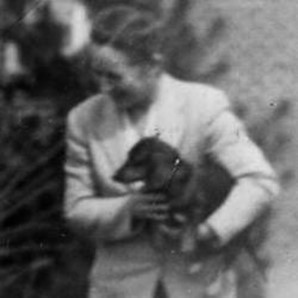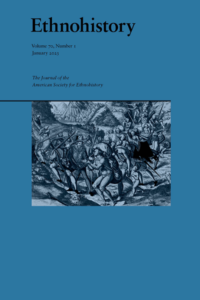Historical Laboratory Projects
The House of Ethnohistory by Abraham Lopez
Ethnohistory is a methodology that combines anthropological and historical approaches. It emerged because traditional methodologies in both disciplines resulted unable to fill in certain gaps of the past, most commonly about indigenous and non-Western populations, which are the primary subjects in ethnohistory. Only the methodology will be specifically examined which should not be confused with Ethnohistory (journal) and the American Society for Ethnohistory (ASE). Although the journal and society are about ethnohistory, they will not be the focus.
The methodology of ethnohistory was born from the Indian Claims Commision Act, created by the U.S. Congress in 1946.[1] Congress formed this commission in an attempt to determine whether indigenous tribes in the United States had received a fair price for their land at the time of its cession to either European settlers or government agents.[2] Native American litigants had to prove that their tribes had occupied and had used ceded areas in question at the time of their tribal treaty ratification by the U.S. Senate or at the time of the establishment of the United States itself.[3] Therefore, tribes needed to provide historical proof of their occupation. It was up to anthropologists to serve as defense witnesses, whose job was to prove that tribes had historically occupied the territory under question.[4] Gathering such proof, forced anthropologists to scour archives and other historical data, thus emerged modern ethnohistory.
In the decades following the ratification of the Indian Claims Commision Act, the field of ethnohistory was in its defining phase. Disciplinary orientation presented one of the roadblocks that faced scholars in their attempts to define ethnohistory.[5] In the infancy of the concept, a significant number of both anthropologists and historians had difficulty conceptualizing ethnohistory.[6] Finally James Axtell defined ethnohistory as “the use of historical and ethnological methods and materials to gain knowledge of the nature and causes of change in a culture defined by ethnological concepts and categories,” which at least reached a basic consensus among most ethnohistorians.[7] While historians and anthropologists had agreed upon the meaning of ethnohistory, they still could not agree upon its nature, which occasionally continues to be debated.[8] However, Bruce Trigger, an archaeologist, pretty much ended the debate on the nature of ethnohistory in 1982, stating, “while ethnohistory can legitimately serve as the name of a methodology it is ethnocentric to use it to designate a discipline.”[9] The ASE agrees that ethnohistory is a methodology that “uses both historical and ethnographic data as its foundation” and is defined as an approach that is “essentially interdisciplinary with primary emphasis centered on the use of history, ethnology and other fields of knowledge employed to understand a culture in its own terms.[10] After so much debate between anthropologists and historians, it seems that a synthesis has not yet been reached.

Ethnohistory does not have founding figures like other methodologies, instead many scholars have polished it throughout its existence. However, among its major figures is Erminie Wheeler-Voegelin. She was born on April I903, the daughter of Erminie Brooke Wheeler and Roscoe Wheeler.[11] Wheeler-Voegelin’s professional career is now primarily associated with her contribution as director of the Great Lakes-Ohio Valley Research Project at Indiana University from 1956 to I969, the date of her retirement.[12] Among her other achievements was becoming president of the American Folklore Society in 1948 and serving as executive secretary for the American Anthropological Association from 1949-1951, a demanding period of changes in the organization.[13] She is famously known for founding the ASE in 1954, where she provided its first definition and popularized the term “ethnohistory,” and became the first editor of Ethnohistory until 1964. Wheeler-Voegelin’s overall contribution is indicated by a long publication record and by her editorial work in the areas of anthropology, folklore, and ethnohistory.[14] The reports were published by the Garland Publishing Company as the American Indian Ethnohistory series in 1974 because the constraints of litigation prevented publication of research until after the cases of the Indian Claims Commission were presented.[15] Even though she had an extensive career, she has been heavily criticized during her life and after death. Wheeler-Voegelin and her fellows who worked for the Indian Claims Commission have been accused of not having the best interests for the indigenous peoples at heart.[16]

Ethnohistory has been riddled with controversies and criticisms throughout its existence. Since 1961, skeptics have questioned its validity to the point of calling an end to the methodology.[17] Ironically, many of ethnohistory’s critics claim that the methodology that aims to consider the culture of indigenous people and relay this cultural sensitivity in any work produced is Eurocentric, racist, and outdated.[18] Specific methods for studying native peoples could potentially lead to biased, racial thinking, much like it had in the nineteenth century when racial determinism dominated anthropological writings on indigenous peoples.[19] However, ethnohistory has become the norm in anthropology and history, so it has been argued that it should no longer be given the special place of prominence that a journal, a society, and a distinct and separate title accord it.[20] Ethnohistory and the ASE have been urged to undergo drastic changes, but the methodology has pretty much stayed the same.

Now to sum up ethnohistory’s methodology. It encompasses archaeology, ethnology, history, and linguistics, and the source materials available to the ethnohistorian include folklore, oral tradition, maps, paintings, and artifacts, as well as written sources.[21] While some anthropologists and historians confine their study to one society or culture, ethnohistorians usually work at the point of contact between two or more, which does place them in the crucible of colonial conflict.[22] The cultures or societies studied in ethnohistories are mostly illiterate. The problems derive, as they so often do, from the methods employed to make the most of the limited source material.[23] Ethnohistorians must often work with scraps of evidence, frequently those written or compiled by the dominant party.[24] However, like anthropologists, they have pioneered reading such materials ‘against the grain’ as a means to recover voices or figures from the past.[25]
Bibliography
Chaves, Kelly K. “Ethnohistory: From Inception to Postmodernism and Beyond.” The Historian 70, no. 3 (2008): 486–513. http://www.jstor.org/stable/24454584.
Green, Anna, and Kathleen Troupe. The Houses of History: A critical reader in twentieth century history and theory. New York: New York University Press, 1999.
Tanner, Helen Hornbeck. “Erminie Wheeler-Voegelin (1903-1988), Founder of the American Society for Ethnohistory.” Ethnohistory 38, no. 1 (1991): 58–72. https://doi.org/10.2307/482791.
- Kelly K. Chaves, "Ethnohistory: From Inception to Postmodernism and Beyond," The Historian 70, no. 3 (2008): 487, http://www.jstor.org/stable/24454584. ↵
- Chaves, "Ethnohistory," 487. ↵
- Chaves, "Ethnohistory," 487. ↵
- Chaves, "Ethnohistory," 487. ↵
- Chaves, "Ethnohistory," 491. ↵
- Chaves, "Ethnohistory," 491. ↵
- Chaves, "Ethnohistory," 492. ↵
- Chaves, "Ethnohistory," 492. ↵
- Chaves, "Ethnohistory," 492. ↵
- Chaves, "Ethnohistory," 493. ↵
- Helen Hornbeck Tanner, “Erminie Wheeler-Voegelin (1903-1988), Founder of the American Society for Ethnohistory,” Ethnohistory 38, no. 1 (1991): 60, https://doi.org/10.2307/482791. ↵
- Tanner, “Erminie Wheeler-Voegelin (1903-1988)," 58. ↵
- Tanner, “Erminie Wheeler-Voegelin (1903-1988)," 64-65. ↵
- Tanner, “Erminie Wheeler-Voegelin (1903-1988)," 68. ↵
- Tanner, “Erminie Wheeler-Voegelin (1903-1988)," 68. ↵
- Chaves, "Ethnohistory," 510. ↵
- Chaves, "Ethnohistory," 505. ↵
- Chaves, "Ethnohistory," 505. ↵
- Chaves, "Ethnohistory," 506. ↵
- Chaves, "Ethnohistory," 510-511. ↵
- Anna Green and Kathleen Troupe, The Houses of History: A critical reader in twentieth century history and theory (New York: New York University Press, 1999), 175. ↵
- Green and Troupe, The Houses of History, 175-176. ↵
- Green and Troupe, The Houses of History, 179. ↵
- Green and Troupe, The Houses of History, 179. ↵
- Green and Troupe, The Houses of History, 179. ↵
